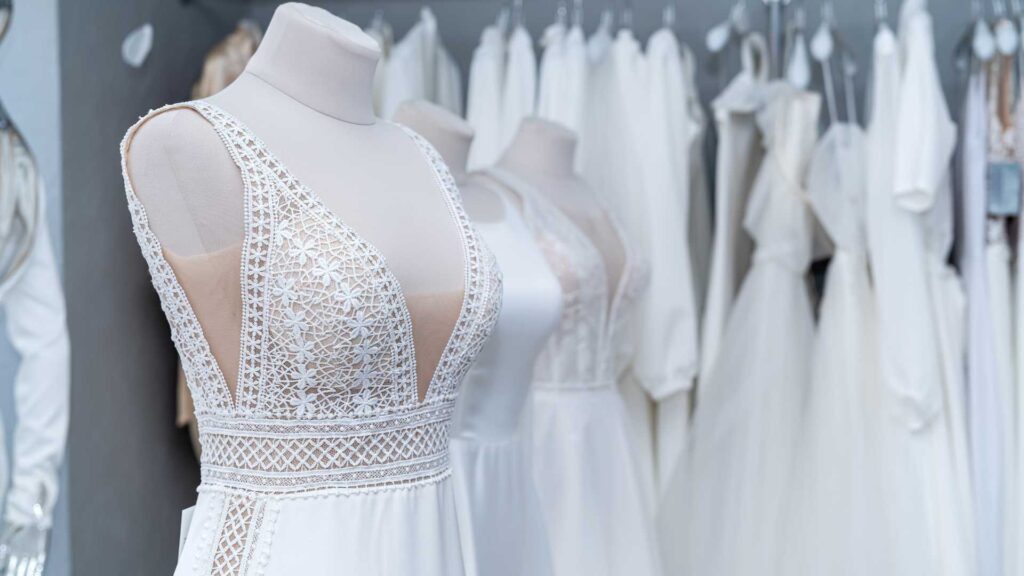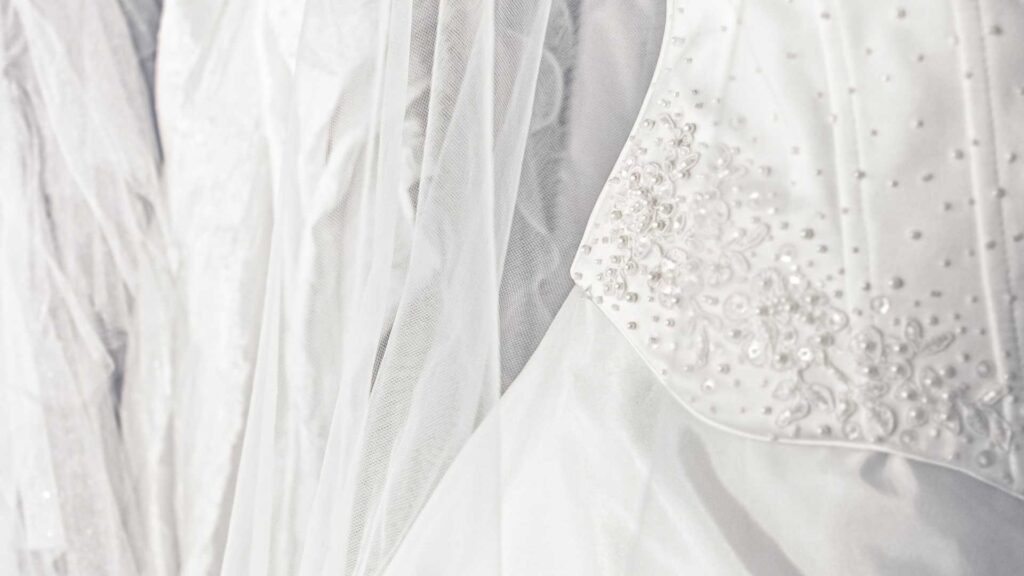When it comes to storing your wedding dress, it’s easy to assume that vacuum sealing will do the trick. I’ve seen it suggested many times, but having worked in the wedding industry for years, I can tell you this method might not be the best choice for preserving your gown. While vacuum sealing may seem like a simple, space-saving solution, it comes with risks—yellowing, mildew, and permanent fabric damage, to name a few. In this article, I’ll explain why vacuum sealing isn’t ideal and guide you through better, safer options for storing your dress long-term.
Why Storing a Wedding Dress Properly Matters
The Importance of Wedding Gown Preservation
When it comes to preserving a wedding dress, the importance can’t be overstated. After the wedding day, many people look for ways to store their dress properly, ensuring its beauty and sentimental value are maintained. The way a dress is stored can significantly affect its longevity and condition, so it’s crucial to choose the right method.
Improper storage can lead to a range of issues that are difficult, if not impossible, to fix. Discolouration, yellowing, wrinkles, mildew, and even fabric damage are all potential risks when the gown is not cared for correctly. That’s why finding the best storage solution is key to preserving your dress and keeping it as beautiful as it was on the big day.
How Poor Storage Choices Affect a Wedding Gown
Over the years, I’ve worked with many brides in Melbourne, and I’ve seen firsthand how different storage methods impact wedding gowns. From yellowing and mould to fabric distortion, poor storage practices can result in irreversible damage. One bride I worked with had her dress vacuum-sealed after her wedding, thinking it would preserve it for years to come. Unfortunately, the compression and lack of airflow caused it to lose its shape, and the dress began to show signs of yellowing. It was heartbreaking, especially considering how carefully she had chosen her gown.
Wedding dresses, like all fine garments, require specific care. The key is understanding the delicate nature of the fabrics and materials, which is why proper storage is essential. Let’s take a closer look at one common method people often consider: vacuum sealing.
Vacuum Sealing a Wedding Dress: Is It a Good Idea?
The Process of Vacuum Sealing Explained
Many brides are drawn to vacuum-sealing their wedding dress, believing it’s a simple and effective way to preserve it. The process involves placing the dress in a bag, removing the air, and sealing it tightly to protect it from dust and moisture. For example, one guest blogger I came across shared her experience using a VacMaster PRO380 vacuum sealer to preserve her gown. She laid her dress flat, folded it, and sealed it using a vacuum machine. Initially, everything seemed perfect: the dress was protected, compressed, and neatly stored away.
However, while this method can offer temporary benefits like space-saving and protection from dust, it’s not ideal for long-term preservation. There are significant risks involved when it comes to storing a wedding gown this way.
The Hidden Dangers of Vacuum Sealing a Wedding Dress
While vacuum-sealing might seem like a neat, space-saving solution, it carries multiple risks that can damage the delicate fabric of a wedding dress over time.
First, let’s talk about compression. Wedding dresses often feature intricate details like lace, beads, and embroidery, which are vulnerable to distortion from compression. The pressure exerted by vacuum sealing can flatten these elements and create permanent creases or even damage the fabric itself.
Additionally, vacuum bags trap moisture inside, creating an ideal environment for mold and mildew. If the gown wasn’t perfectly dry when sealed, trapped moisture can lead to stains that are difficult to remove. There’s also the issue of plastic bags releasing harmful gases as they degrade. These gases can yellow the fabric and weaken it, causing long-term damage.
The Risks of Using Vacuum Sealing for Wedding Dress Preservation
Yellowing and Discolouration from Plastic Bags
One of the most concerning risks of using vacuum bags is the potential for yellowing or discolouration over time. You might think plastic bags will keep your dress safe from the outside world, but the reality is that plastic can actually cause long-term damage. The plastic used in these vacuum bags is not always made from high-quality, breathable material. Over time, the chemicals in the plastic can break down and emit gases that interact with the fabric, leading to yellowing.
I once had a couple from Fitzroy approach me after storing their wedding dress in a vacuum-sealed bag for several years. When they finally opened the bag, they were devastated to find that the gown had taken on a yellowish tint. The beautiful ivory fabric, once pristine, had changed colour due to the plastic’s chemicals. This wasn’t something they could undo with a simple cleaning.
In fact, many fabric experts warn against using plastic for long-term storage because the fumes from plastic slowly deteriorate delicate fabrics, leaving them discoloured and damaged.
Mould and Mildew Growth in Vacuum-Sealed Bags
The second issue that arises from vacuum sealing is moisture retention. When a wedding gown is sealed in a vacuum bag, there is no chance for the fabric to breathe. Even a small amount of moisture left in the fabric can get trapped inside the bag, creating the perfect environment for mold and mildew. This moisture buildup can be especially problematic if the gown wasn’t completely dry before being sealed, or if the storage conditions weren’t ideal.
A bride I worked with from Ballarat learned this the hard way. After sealing her gown in a vacuum bag, she kept it stored in a humid area of her home for several months. When she opened it, she discovered mildew stains along the hem and in delicate areas like the bodice. Unfortunately, the mildew had left permanent marks, and she had to seek professional cleaning services, which were costly and didn’t completely restore the gown.
When it comes to preserving a wedding dress, moisture is a major enemy. That’s why breathable materials and proper airflow are essential to avoid these issues.
Permanent Creasing and Fabric Damage from Compression
Another risk with vacuum sealing is the pressure it places on the fabric. The compression from vacuum sealing, which might seem like a good space-saving technique, can actually cause permanent creases in delicate wedding gown fabrics. Fine silks, satins, and laces are particularly vulnerable to this kind of damage. The pressure from vacuum bags can distort the gown’s shape and cause lasting fabric wear, particularly in areas like the bust, shoulders, and sleeves.
I’ve seen it happen with one particular gown I worked with—a beautiful silk dress with intricate beading. The bride, hoping to preserve the gown for her daughter in the future, vacuum-sealed it to save space. However, when she later went to take it out, she noticed the beads had been flattened and the fabric had visible creases that couldn’t be undone. The compression from the vacuum bag had caused irreparable damage.
With delicate fabrics, compression isn’t something that can be easily reversed. Once the fabric is compressed and distorted, it can lose its integrity and overall appearance. This is another reason why experts advise against vacuum sealing for wedding dress storage.
Better Alternatives for Storing Your Wedding Dress
Breathable Garment Bags: The Best Option for Short-Term Storage
If you’re looking for a solution that offers safe storage for a wedding gown in the short term, breathable garment bags are the way to go. These bags allow the gown to breathe, which helps prevent moisture buildup that could lead to mildew or mould. Unlike plastic bags, breathable garment bags made of cotton, muslin, or polyester blends are designed to keep the fabric in great condition without causing yellowing or damage.
I often recommend breathable garment bags to brides who are storing their gowns for a year or two, or who plan on taking the gown on a trip for preservation. One couple from Geelong used a high-quality cotton garment bag to store their gown during their honeymoon trip to Europe, and when they returned, the dress was in perfect condition. The key here is choosing a garment bag that’s large enough to accommodate the dress without crumpling the fabric or embellishments.
For those with delicate gowns, I recommend hanging the dress using a padded, sturdy hanger. This helps distribute the weight evenly, preventing any stretching or distortion.
Long-Term Storage: The Benefits of Acid-Free Storage Boxes
For long-term preservation, acid-free storage boxes are a far better option than vacuum sealing. These boxes are specially designed to protect wedding gowns from acid, lignin, and other harmful elements found in regular cardboard boxes. Acid-free boxes help to maintain the gown’s integrity over the years, preventing the fabric from yellowing, fading, or deteriorating.
When it comes to long-term storage, I’ve seen brides opt for acid-free boxes and I’ve recommended this solution many times. For example, a client from St Kilda came to me with a heavy satin wedding gown that she wanted to preserve for her future daughter. We carefully folded the dress, added acid-free tissue paper between the folds, and placed it in a large acid-free box. The gown was stored in a cool, dry place for several years, and when she took it out to show her daughter, the dress looked just as beautiful as it did on her wedding day.
For best results, ensure the box is large enough to fit the gown without compressing it. Place tissue paper between folds to avoid creating sharp creases. Also, remember that the box should not be sealed airtight—your gown needs airflow to stay fresh.
Professional Wedding Dress Preservation Services
If you want to ensure your gown is in the best possible condition for years to come, consider professional wedding dress preservation services. These services often include cleaning, stain removal, repairs, and packaging in museum-quality materials that protect the fabric and preserve the gown’s beauty.
I’ve personally worked with several preservation companies, and I can tell you they are worth the investment, especially for delicate or high-value gowns. A professional service will handle your gown with the care it deserves, ensuring that it remains in pristine condition long after your wedding day. Prices for professional preservation vary, but expect to pay between $160 and $250 for basic services, though more intricate gowns or specialised preservation can go for upwards of $1,200.
Essential Tips for Wedding Dress Storage: Best Practices to Follow
Pre-Storage Cleaning and Maintenance Tips
One of the most important steps in preserving a wedding dress is to ensure it’s clean before it’s stored. It’s easy to overlook this step, but even invisible stains can cause irreversible damage over time. Oils from your skin, perfume residue, or even sweat can cause yellowing or fabric deterioration if left untreated.
Before storing your gown long-term, I always recommend having it professionally cleaned by a specialist who has experience with delicate wedding dresses. I’ve worked with many brides who chose to have their gowns cleaned after the wedding, and the difference in the condition of the dress after cleaning was night and day. Even subtle stains—like perfume marks or a bit of dirt from dancing—can cause problems if not dealt with immediately.
When the cleaning process is complete, it’s important to check the dress thoroughly for any spots that may have been missed. A reputable cleaner will often provide a post-cleaning inspection, ensuring the gown is in pristine condition before storage.
Where and How to Store Your Wedding Dress for Optimal Preservation
The next thing to consider is the environment in which you store your wedding gown. The ideal storage location should be cool, dry, and dark. Avoid storing the dress in areas prone to temperature fluctuations or high humidity, such as attics, basements, or garages. These environments can contribute to mould, mildew, and fabric deterioration.
A climate-controlled room is the best option for long-term storage. When I advise couples on the best place to store their wedding dresses, I often recommend a closet or storage area that is well-maintained and protected from direct sunlight, heat sources, and moisture.
Another important consideration is how the gown is hung or laid out. If you are using a breathable garment bag, be sure to hang the dress on a sturdy, padded hanger to avoid stretching the fabric. For heavier gowns, avoid hanging them for too long, as this can cause the weight of the fabric to distort the shape. A good solution is to store the gown flat in an acid-free storage box, where it can be supported and protected.
Avoiding Common Mistakes When Storing Your Wedding Dress
As a wedding expert in Melbourne, I’ve seen my fair share of mistakes when it comes to wedding dress storage. One of the most common errors is leaving the dress in plastic bags. Plastic is a material that traps moisture and can lead to yellowing or even mildew growth. Always remove any plastic covering that may have come with the gown, especially if you plan on storing it for a long period of time.
Another mistake I’ve seen is using the wrong type of tissue paper. Never use coloured tissue paper when storing your dress, as the dye can transfer onto the fabric over time. Stick to acid-free tissue paper to keep the gown safe and preserve its original condition. Similarly, avoid using mothballs, as they can emit strong odours that are difficult to remove and may damage the fabric.
Finally, one of the most important things to remember is to handle your gown with care. Always ensure your hands are clean and free from oils or dirt before touching the dress. Using gloves can be a good idea to prevent any accidental stains or smudges. And, of course, always zip up, button, or fasten any closures before storing the dress to keep its shape intact.
The Best Way to Preserve Your Wedding Dress
Why Vacuum Sealing Should Be Avoided
While vacuum sealing may seem like an easy solution to store your wedding gown, the risks involved make it a less-than-ideal method. The compression, lack of airflow, and potential for moisture buildup can all lead to serious problems, including yellowing, mould, and permanent fabric distortion.
After reviewing the potential downsides of vacuum sealing, it’s clear that traditional methods, such as breathable garment bags or acid-free storage boxes, are far safer and more effective for long-term preservation. These options provide the protection your gown needs while allowing the fabric to breathe, which is essential for maintaining its beauty.
Key Takeaways for Protecting Your Wedding Gown
- Always have your wedding dress professionally cleaned before storing it to remove any oils, stains, or residue.
- Use breathable, non-plastic garment bags for short-term storage and acid-free boxes for long-term storage.
- Avoid areas with fluctuating temperatures or high humidity—store your dress in a cool, dry, dark place.
- Handle the dress with care, using gloves if necessary, and ensure it is properly zipped or fastened before storing.
- If in doubt, consider investing in professional wedding dress preservation services to ensure your gown stays in top condition for years to come.
Let’s Get Straight to the Point
Vacuum sealing your wedding dress might seem like a good way to preserve it, but it carries significant risks. The compression and lack of airflow can lead to yellowing, mould growth, and permanent fabric damage. Instead, opt for safer storage methods like breathable garment bags for short-term storage or acid-free storage boxes for long-term preservation. Professional preservation services offer the best protection, especially for delicate gowns. Proper cleaning and careful handling are crucial for keeping your wedding dress in top condition for years to come.




